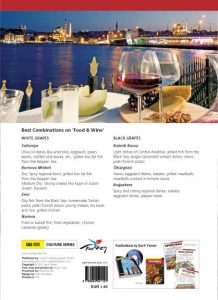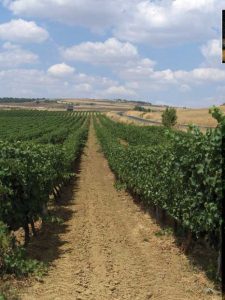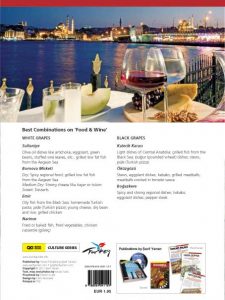Wines of Turkey
Wines of Turkey (Turkey Wines) has a rich wine production history dating back thousands of years. While it might not be as widely known as some other wine-producing regions, Turkish wines have been gaining recognition for their quality and uniqueness in recent years.
“Wines of Turkey” by Murat Yanki
A user friendly and informative Pamphlet with maps and photos. Its content is very easy to understand. The lands of Turkey have been the earliest places to cultivate vineyards since the Bronze Age. This pamphlet gives brief information about wine regions of Turkey, local and international grapes grown in Turkey, recommended wines readily available in Turkey and best combinations on Food & Wine. This guide is also perfect for cruise ship passengers on their shore excursions as they have limited time in Turkey. With this guide, readers can easily try Turkish Wines.
ISBN 9786054541157 Wines of Turkey (English)
Available at Museum Shops in Turkey
Here are some key points about the wines of Turkey:
 Grapes and Varietals: Turkey is home to numerous indigenous grape varieties that are not commonly found elsewhere. Some of these include Öküzgözü, Boğazkere, Narince, Emir, Kalecik Karası, and more. Additionally, international grape varieties like Cabernet Sauvignon, Merlot, Chardonnay, and Sauvignon Blanc are also grown.
Grapes and Varietals: Turkey is home to numerous indigenous grape varieties that are not commonly found elsewhere. Some of these include Öküzgözü, Boğazkere, Narince, Emir, Kalecik Karası, and more. Additionally, international grape varieties like Cabernet Sauvignon, Merlot, Chardonnay, and Sauvignon Blanc are also grown.- Regions: Turkey has several wine-producing regions, with the most notable being Thrace (including the subregion of Gallipoli), Anatolia (Central Anatolia and Eastern Anatolia), and Aegean Anatolia. Each region has its own unique terroir, climate, and grape varieties.
- Wine Types: Turkish winemakers produce a variety of wine types, including red, white, and rosé wines. There are also some traditional styles like “şarap” (wine fermented with grape skins) and “bozcaada” (an aged red wine produced on the island of Bozcaada).
- Wineries: Over the past couple of decades, many boutique wineries and larger producers have emerged in Turkey. Some well-known Turkish wineries include Kavaklıdere, Kayra, Doluca, Vinkara, and Chamlija, among others.
- Cultural Significance: Wine has historical and cultural importance in Turkey. The country’s ancient roots in winemaking can be traced back to civilizations like the Hittites and Phrygians. However, due to various historical, cultural, and religious factors, wine production and consumption have had their ups and downs over the centuries.
- Recognition: Turkish wines have been earning recognition in international wine competitions and gaining attention from wine enthusiasts and professionals worldwide. Indigenous grape varieties and unique terroirs contribute to the distinct character of Turkish wines.
- Wine Tourism: Some Turkish wine regions, such as Cappadocia and Thrace, have become popular destinations for wine tourism. Wineries often offer tours, tastings, and wine-related experiences for visitors.
If you’re looking for the most up-to-date information about the wines of Turkey, I recommend checking reputable wine resources, websites of Turkish wineries, and recent travel guides.
In Which Regions Are Turkish Wines Produced?
T
urkish wines are produced in several different regions throughout the country. Each region has its own unique climate, soil composition, and grape varieties, which contribute to the diversity of Turkish wines. Here are some of the key wine-producing regions in Turkey:
- Aegean Region: This region is one of the most important wine-producing areas in Turkey. It includes subregions such as Izmir, Manisa, and Denizli. The Aegean region is known for producing both red and white wines, and it’s home to indigenous grape varieties like Kalecik Karası, Öküzgözü, and Boğazkere.
- M
 armara Region: This region includes the subregions of Thrace and Gallipoli. Thrace, located in northwestern Turkey, is known for its diverse range of wines, including both indigenous and international varieties. The Gallipoli Peninsula is recognized for its unique terroir and wine production.
armara Region: This region includes the subregions of Thrace and Gallipoli. Thrace, located in northwestern Turkey, is known for its diverse range of wines, including both indigenous and international varieties. The Gallipoli Peninsula is recognized for its unique terroir and wine production. - Central Anatolia: This region encompasses areas like Cappadocia and Konya. Cappadocia is famous for its distinctive volcanic soil and produces a variety of wines, particularly white wines made from the indigenous Narince grape.
- Eastern Anatolia: This region, with its high altitudes and diverse climates, is challenging for viticulture due to its harsh winters. However, some wineries in this region are producing unique and distinctive wines.
- Southeastern Anatolia: This warm and arid region is not as well-known for wine production compared to some other areas, but efforts are being made to cultivate vineyards and produce wine.
- Mediterranean Region: This region includes subregions like Antalya and Adana. The Mediterranean climate is suitable for grape cultivation, and wines from this area are becoming increasingly recognized.
- Black Sea Region: The humid and rainy climate of this region presents challenges for viticulture, but some wineries are working with local varieties to create wines with character.
- Aegean Islands: Islands like Bozcaada and Gökçeada in the Aegean Sea have a long history of winemaking. These islands are known for producing unique wines using indigenous grape varieties.
Remember that the wine industry is dynamic, and new areas may also emerge as viticultural regions. The diversity of climates and soils in Turkey contributes to the wide range of wines that the country produces. If you’re interested in specific details about Turkish wine regions and their products, it’s a good idea to refer to recent wine guides, winery websites, and reputable wine resources.









